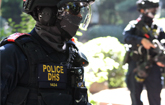Finding Insurgent Threats in Afghanistan with SCARE Technology
COLLEGE PARK, Md., April 8, 2011 /PRNewswire-USNewswire/ -- A new version of the University of Maryland's SCARE analytical computational technology can help U.S. military analysts and planners find large caches of insurgent weapons, insurgent commanders and other "high value targets" in Afghanistan, say University of Maryland researchers in a paper accepted for publication in the 2011 International Conference on Innovative Applications of Artificial Intelligence.
The Maryland-developed SCARE (Spatio-Cultural Abductive Reasoning Engine) technology combines a variety of geographical, cultural and incident information with an computational analysis technique called geospatial abduction to create an analytical tool that was first developed to analyze patterns of improvised explosive device (IED) attacks in Iraq and predict the locations of IED weapons caches. The new paper outlines the abilities of a second-generation SCARE-S2 software specially designed for Afghanistan and currently available for military use.
"U.S. commanders can use our geospatial abduction techniques to 'zoom in' on regions that have a high probability of containing HVTs (high value targets). In our study in Helmand and Kandahar provinces, half the regions we identified definitely contained an HVT. In addition, other regions we identified may well have contained an HVT because our ground truth data said there was an HVT in the province, without pinpointing the location," say authors Paulo Shakarian a U.S. Army Captain and Ph.D. candidate in computer science, political scientist Margo Nagel, criminologist Brittany Schuetzle and V.S. Subrahmanian, a professor of computer science and director of the university's Lab for Computational Cultural Dynamics.
The authors report that the regions they discover with SCARE-S2 contain, on average, just 4.8 villages, and have a density of high value targets that is 35 times greater than in the Helmand and Kandahar provinces as a whole. "In order to achieve this, we had to understand both the tribal geography of these two provinces and the geospatial constraints that insurgent groups have to operate under - and to do so, we had to assemble a multidisciplinary team, get them to work together on understanding which tribes were where in the region, and then develop the computational models to identify regions containing HVTs," said author Subrahmanian.
"The region geospatial abduction technique used here will help ground commanders focus intelligence assets on small, target-rich areas," said Shakarian whose doctoral research focuses on this topic. Shakarian, who served two combat tours in Iraq, adds that, "The goal of this research was to help the warfighter better locate the enemy. We can deal a significant blow to an insurgent group by targeting large caches and leadership in this way."
"I am convinced that SCARE-S2 will help focus the limited Intelligence, Surveillance, and Reconnaissance (ISR) assets on the most likely locations of IED cells and the caches of explosive materials which are used to build the IED weapons our troops face on a daily basis," said LTG (Retired) Charles Otstott who previously served in Vietnam and was Commander of the 25th Infantry Division (Light). "Finding the material before it becomes an IED is critical to our success against this terrible weapon," he said.
The University of Maryland team pinpoints regions with just 4.8 villages on average, allowing commanders to focus on just those few villages in their attempt to interdict the insurgency. A more detailed technical paper on region geospatial abduction, invented by Shakarian and Subrahmanian, has been accepted for publication in the book Counterterrorism and Open Source Intelligence (ed. U.K. Wiil) to appear in July 2011.
The research further advances previous SCARE results on IED attacks in Baghdad by the same University of Maryland team where they used a simpler form of geospatial abduction to pinpoint locations of small IED caches to within 0.45 miles. Unlike that effort where the attacks were carried out in a small, but dense, urban environment, this effort focused on a much larger region (580 x 430 km.) comprising two whole provinces of Afghanistan that are sparsely populated and where open source data to carry out the study was of much poorer quality.
The SCARE and SCARE-S2 mathematical formulas are both based on abductive reasoning. Classical deductive reasoning tries to state what follows from a set of facts, while abduction tries to find the best explanation for a set of observations.
UMD Tech Joins Computer & Social sciences
Other technologies joining the power of computer science with the behavioral and social sciences that have been developed by Subramanian and University of Maryland colleagues include the SOMA Terror Organization Portal (STOP) software and OASYS, a unique, award-winning system for online opinion analysis. The STOP tool can allow analysts to query automatically learned rules on terrorist organization behavior, forecast potential behavior based on these rules, and, most importantly, to network with other analysts examining the same subjects.
MORE INFORMATION
SCARE website with link to latest paper at: http://www.umiacs.umd.edu/research/LCCD/projects/SCARE.jsp
Read Nature article "Social science: Web of war" that quotes Subrahmanian and mentions the Maryland SCARE Technology. http://www.nature.com/news/2011/110330/full/471566a.html
Read more about the work of Subrahmanian and the University of Maryland's Laboratory for Computational Cultural Dynamics. http://www.umresearch.umd.edu/impact/impact_profiles1/Wilkenfeld_Subrahmanian.pdf
SOURCE University of Maryland
WANT YOUR COMPANY'S NEWS FEATURED ON PRNEWSWIRE.COM?
Newsrooms &
Influencers
Digital Media
Outlets
Journalists
Opted In



Share this article